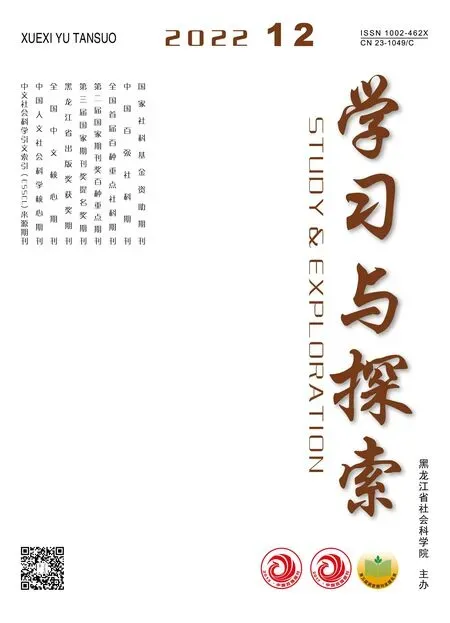ABSTRACTS
TheMulti-dimensionalDevelopmentofMarxisminthe21stCentury——CommentonMarxinMultiplePerspectives
ZHOU Ai-min
(SchoolofMarxism,TongjiUniversity,Shanghai200092,China)
Abstract:The book Marx in Multiple Perspectives: The Development Trend of World Marxism in the 21st Century written by Professor Wang Fengcai and others, focusing on the theme of “Research on the Development Status and Prospects of World Marxism in the 21st Century”, has carried out interdisciplinary, holistic, all-round and multi-dimensional research, which not only established the basic framework, outlined the basic pattern and analyzed the path of interpretation of the world Marxism in the 21st century, but also defines and reveals the problem areas, hot issues, difficult issues, and key issues of the research on world Marxism in the 21st century, predicts the future prospects, examines the significance and clarifies the correct attitude of the research on world Marxism in the 21st century. This book combines five regions and five interpretation paths to illustrate the development of world Marxism in the 21st century, and can better show the development characteristics of Marxism in various regions in the 21st century. It can integrate the hot issues of the research on 21st century world Marxism and roughly outline the 21st century world Marxist discourse system from the perspective of three levels, which are compilation and interpretation of classic texts, neoliberal capitalism criticism, and the conception and practice of new socialism. As the first leading-edge and tracking research on “World Marxism in the 21st Century” on an international scale, this book not only creates a precedent for systematic research on world Marxism in the 21st century, but also reflects the expansion and deepening research on Marxism in China, which can effectively promote the further development of follow-up in-depth and integrated research.
Keywords:Marx; Marxism in 21st Century; Capitalism; Socialism
UrbanandRuralCultureinTransformationandRuralRevitalization
YAN Ze-hua1; WANG Tian-fu2
(1.FacultyofHumanitiesandSocialSciences,BeijingUniversityofTechnology,Beijing100124,China; 2.DepartmentofSociology,TsinghuaUniversity,Beijing100084,China)
Abstract:In the current context of social transformation, to achieve rural revitalization through urban-rural integration development requires not only the cooperation of the economy, but also the resonance of urban and rural culture. This paper reviews the changes in the perspective of urban sociology theory from the typification to the differences of urban and rural cultures and summarizes the inherent differences between Chinese and Western cultures. Combining the historical and cultural relationship between urban and rural areas in China and the current transformation background, this paper proposes that rural development should pay attention to urban and rural reality on the basis of respecting the differences, break the cultural opposition, and realize rural revitalization. Among them, social participation is an important force for the integration of urban and rural cultures, and the development of digital technology provides a favorable opportunity for it.
Keywords:Urban and Rural Culture; Urban Culture;Rural Revitalization; Urban and Rural Integrated Development; Digital Technology
TheHistory,TheoryandContemporaryDevelopmentoftheGreatSocialistUnifiedMarket
ZHANG Xu1, SUI Xiao-tong2
(1.InstituteofEconomics,CASS,Beijing100836,China; 2.SchoolofMaxism,OceanUniversityofChina,QingdaoShandong266100,China)
Abstract:The market appears with the development of division of labor and social productivity. The market is not only the place of economic activities, but also the sum of commodity trading relations. It plays the role of resource allocation, but at the same time, the market is regulated by the government. Chinese traditional society is typical of a centralized country, which creates conditions for the establishment of a large market. It not only creates the space level, big market, and product variety of the market, such as tangible market scale and with the development of social productivity and expanding, so as to form the contains production data market, financial market, labor market, such as the unification of the large market. After the founding of the People’s Republic of China, the development of the Great Unified Market has gone through the embryonic stage, the stage of cultivation and growth, and the stage of high-quality development. After the establishment of the socialist market economy system, the Great Unified market of China has entered the stage of rapid development, but new problems have also arisen. The timely introduction of the Opinion puts forward a higher request for the construction of the “unified big market”, because this is not only the request for further development of the current socialist productive forces, but also the core problem of perfecting the socialist market economy system, and is in the new development stage, the strategic support of constructing a new development pattern.
Keywords:Unified Big Market; New Development Pattern; Socialist Market Economy
LotmanandJakobson:EncountersandCrossings
Igor Pilshchikov1,2
(1.UniversityofCalifornia,LosAngeles,theUS; 2.TallinnUniversity,Tallinn,TheRepublicofEstonia)
HUANG Mei, Trans.
(InstituteoftheRussianLanguage,BeingForeignStudiesUniversity,Beijing100089,China)
Abstract:The aim of this paper is to analyze the similarities and differences between Juri Lotman’s and Roman Jakobson’s approaches to the questions of literary history, literary theory, and cultural semiotics. Topics are discussed including Jakobson and Lotman as intellectual leaders of their generations, Jakobson’s influences on Lotman’s research in medieval Russian literature and Pushkin studies, Jakobson’s and Lotman’s attitude to binarism in the structural-functional approach to languages and literatures, the Jakobsonian and Tynianovian genesis of Lotman’s concept of minus-device, and Lotman’s critique and reintepretation of Jakobson’s schema of communication.
Keywords:Juri Lotman; Roman Jakobson; Literary Structuralism; Cultural Semiotics

